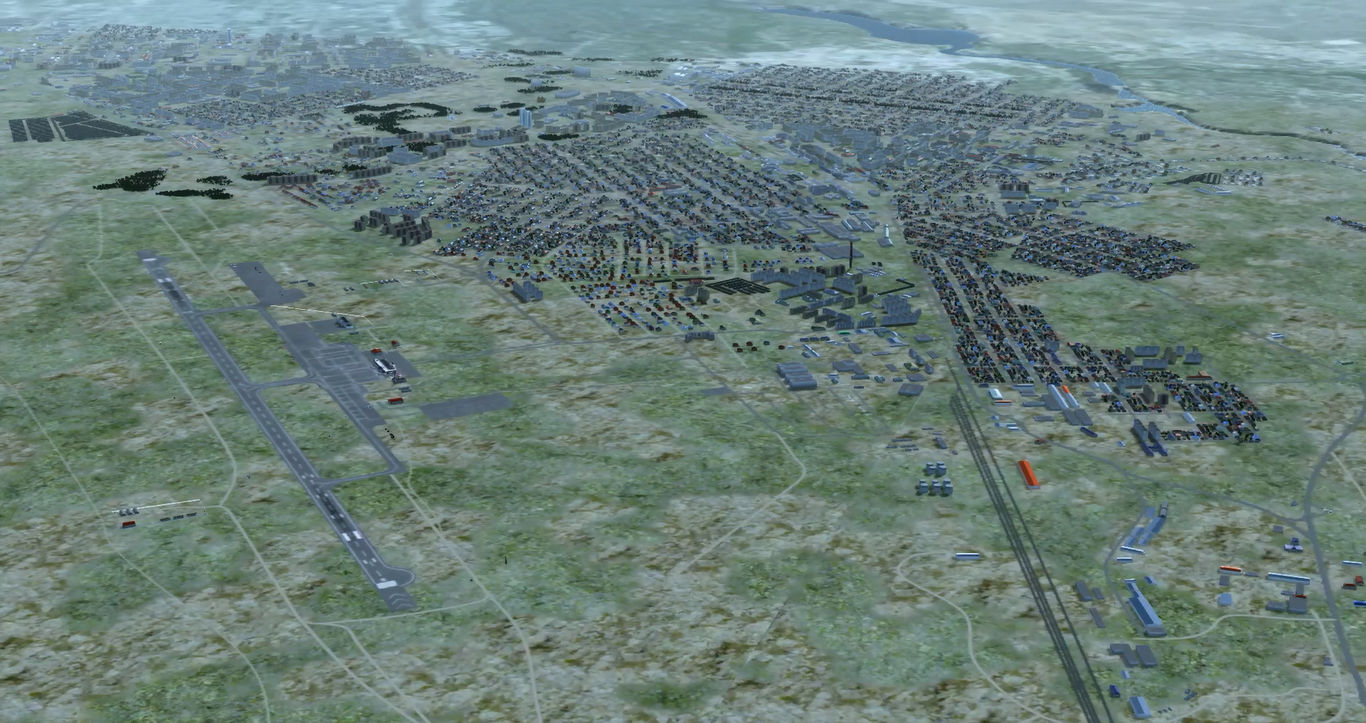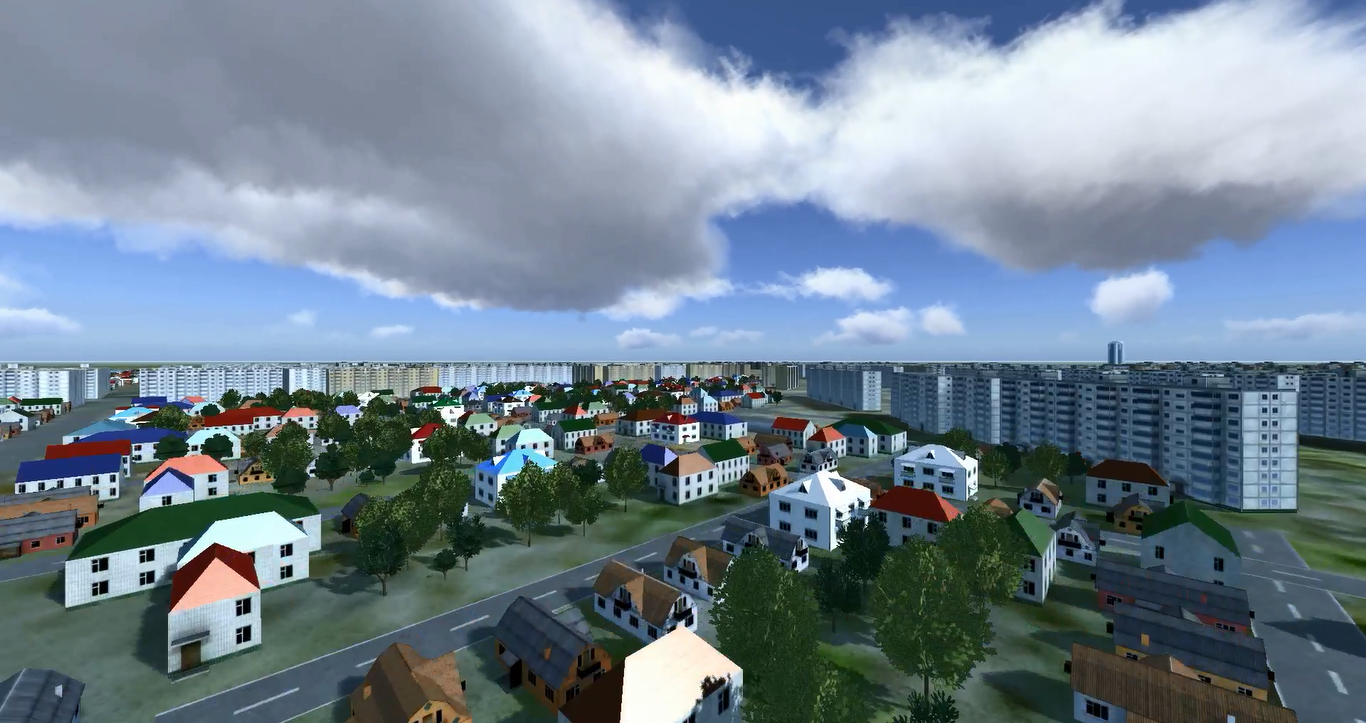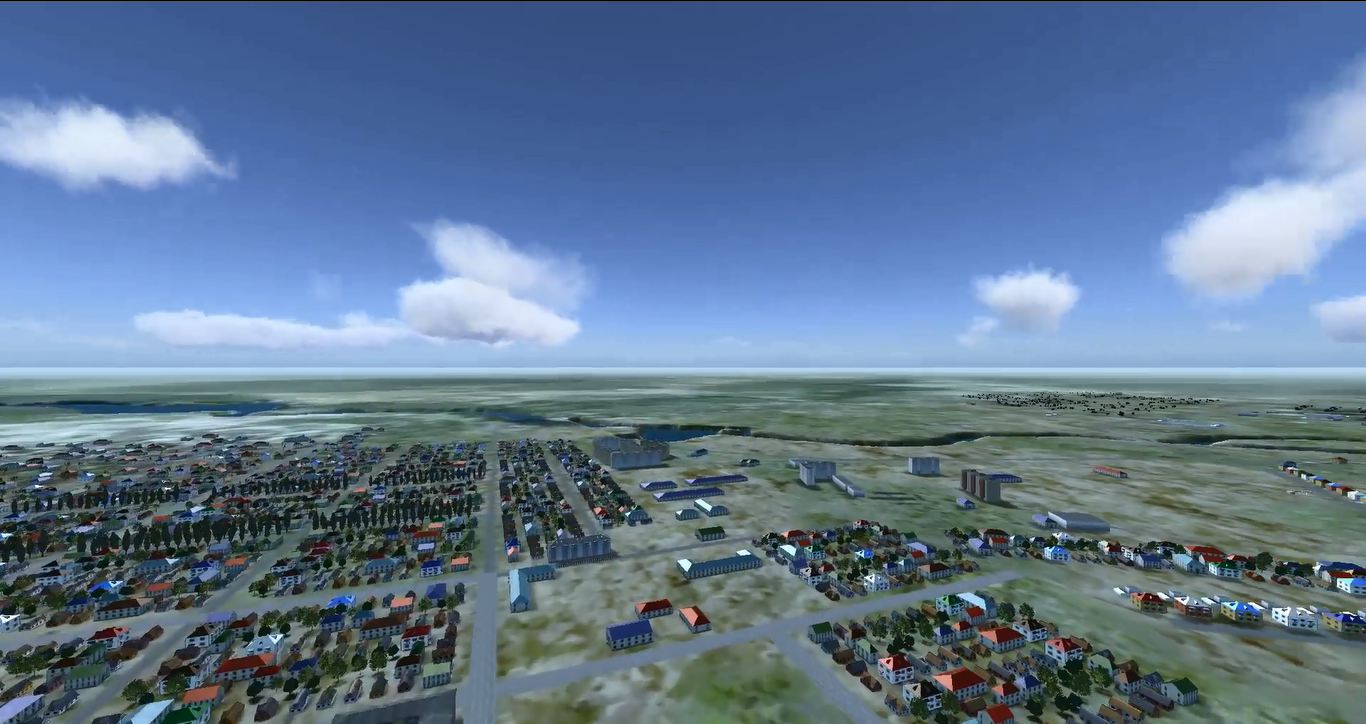FFS (Full Flight Simulators) / FMS (Full Mission Simulators)
Here is screenshot from helicopter flight using PC. Same code is using for flight using computer appliance simulators. On-screen scales are just a feature for simplifying testing.
Overview
We develop software for FFS/FMS computer appliance simulators for crew trainings.
We model all necessary aspects of simulators:
- aerodynamic modelling with taking into account external factors;
- interactions with motion platform;
- cockpit devices and visualization systems;
- replicating of real world areas in Outside World with different environment conditions;
- high quality visualization of Outside World;
- modelling of all on-board systems;
- interaction with crew by controls and gauges
Our software is used in full-sized hardware/software FFS/FMS simulators with cockpits that have a visualization system and realistic interior based on motion platforms (6DOF or other types).
Here you can see flight of helicopter. So, gamepads are used here to control the flight, and helicopter devices are visualized on 2D view. But this code also is using with motion platform and hardware controls interactions
We develop Full Mission Simulators (FMS) software for crew trainings and for their studying not only to handle an aircraft but also to complete battle mission tasks in realistic simulated training environment. With simulators based on our software pilots can train to act together for formation flights or complete missions tasks, for crew training, for acting crew with dispatchers (or air control officers) or act together in big training environment with different types of simulators using HLA protocol (or another interoperability protocol on customer’s request). More than 100 standard exercises can be completed with these simulators.
We develop our simulators based on architecture approach.We extract everything that can be reused in other simulators or in the same simulator as a reusable module. Using this approach we have a universal skeleton platform with reusable architecture blocks that can be used for development of new simulators with minimal efforts or for rapid extension of existing simulators with new features according to customer’s needs.
Our architecture is loosely coupled and this is one of our core principles, every architecture block can be changed or extended. This key point allows us easily to support, for example, different hardware, data sources, display systems etc.
So, our approach allows us to develop a new simulator or extend the existing one rapidly, with minimal efforts, costs and terms. You can read more about our architecture approach in subsection of this section.
Key points of our FFS/FMS software services
Advanced flight simulation development
- Simulation for complex training both procedural and flight operations (turning on, driving, takeoff, landing, flight operating, manoeuvring, technical failures operating, firing, bombing, etc.)
- Simulation of flight dynamics using physics principles, strong mathematical modelling, including aerodynamic modelling based on aircraft parameters. We have subject-matter experts for projecting and implementing such tasks.
- Modelling of atmospheric effects, weather, time-of-day and season conditions for training pilots to operate in different conditions (for example, such parameters as wind, temperature, turbulence, density, humidity, flying on low altitudes affect the aerodynamics of a flight; rain, snow, fog, clouds, sun shine, time-of-day light visual effects are modelled for teaching a crew to operate in different visual conditions)
Network & Interoperability
- Network interactions with other simulators or simulator parts using HLA 2010 Evolved protocol to train aircrew or for training formation flights and execution of formation combat missions. Support of integration with other simulators for performing military cross-branches trainings with different types of simulators.
- Support of HLA integration with air traffic control simulation to teach pilots and dispatchers (or air control officers) to work together.
Working with hardware and hw simulation
- Simulation of on-board systems based on electrotechnical schemes. Our electrotechnical engineers can describe on-board devices model and implement it with our developers. Inner logic, interactions with hardware devices, visualization of devices on Instructor Operating Stations we can implement for a trainee to be able to study working with on-board systems effectively
- Integration with different types of motion platforms (including 6 degrees of freedom platforms), controlling vibration system
- Support of different types of cockpit visualization systems (for example, a spherical screen with a set of stuck together images from different projectors)
- In-cockpit realism development: software for controlling devices illuminations, in-cockpit sounds, outside world related sounds, managing device controls force feedbacks etc.
On-Board system framework models the work and cooperation of on-board devices during simulation. The approach is to maximally model the inner work of some real aircraft’s On-Board system based on the electro-technical schemes of the aircraft.
Instructor operating development
- Instructor operating stations development where an instructor can monitor flight and mission tasks operating, state of on-board devices, environment in 3D and on the maps, introduce device malfunctions etc. Also monitoring of soft for a media classroom showing the current training in different views. Multi monitor workstations are used for providing such information.
- Recording of all distributed activities during simulation for debriefing and after-action review across distributed environment with the possibility to replay the simulation from any point. Action controls for starting, pausing or stopping the simulations.
- Development of mission and environment editors for the preparation of different trainings. Modelling of airport facilities and environment to teach pilots to operate with them.
3D, terrain, AI and synthetic environments
- Realistic modelling of a real-world terrain area with automatic approach, using elevation data, digital vector maps, terrain imagery and 3D models typical for the region or automatic terrain generation according to the customer’s needs
- Rich 3D visualization development of huge terrain areas in hundreds of thousands of square kilometers with correspondence of this area to the real world (same elevation, land types, objects etc.)
- Virtual world and AI simulation development. Distributed algorithm that calculates movements and actions of all the units according to mission editor tasks and their parameters. AI simulates complex patterns like decision making, aim selection, shooting etc. We take into account lots of parameters when developing a virtual world: parameters of each ground or air unit (configurable into editors), relief, land types, movement capabilities etc. True physics and ballistic principles are used in the simulation core. nVidia PhysX is used for high-performance of physics-related operations
Here you can see restoration of one of real-world city using digital vector maps, terrain imagery, 3D models library and SRTM elevation map. You can see a roads, river in the top-right, city blocks and bush / tree areas that are generated automatically from correspondent vector map. Airport environment in bottom left was added manually
Here you can see city blocks automatically generated from digital vector map data using typical for this region 3D models. Roads are automatically generated too due to digital vector map.
Geospatial development
- Geospatial related development: using a map for dynamic air and ground environment visualization, for editing environment etc.
Here you can see relief of terrain that is used in model. This relief is taken from SRTM elevation data and corresponds to terrain in this region.
Air traffic related simulation
- Virtual air traffic modelling using flight dynamic principles and with terrain following
As our simulator is network-based, we develop software for the whole simulator that can, for example, consist of the following software interface modules:
- Out-of-cockpit visualization system
- Interaction with cockpit devices and in-cockpit sound and illumination systems
- Interaction with a motion platform
- Instructor operating stations to control the studying process, play up to own, allied or alien forces or introduce on-board devices faults
- Multimedia classroom visualization system for staff with 3D and 2D (on a map) visualization of crew actions and current air and ground environments
Our simulators can be a part of more complex training systems. For example, our FMS aircraft simulators act together with air traffic control simulator for simultaneous training of dispatcher and pilots crews.





